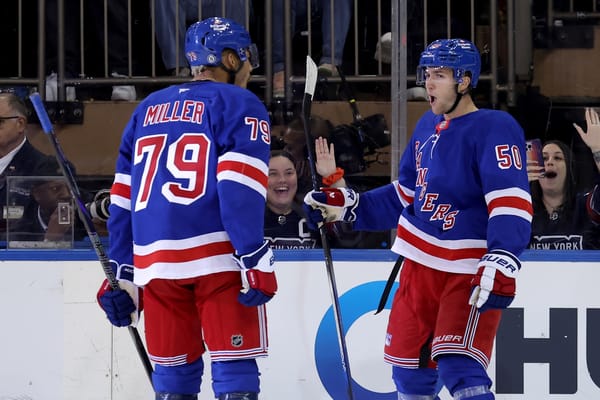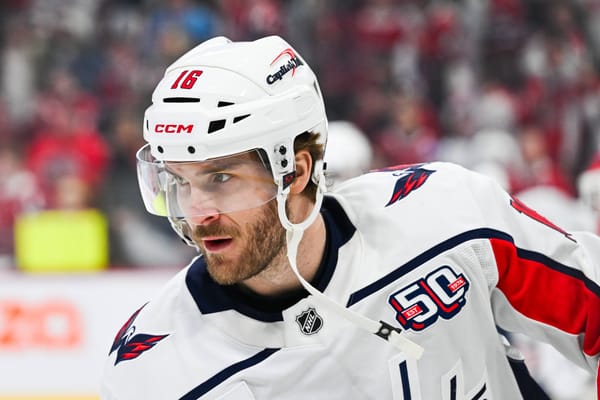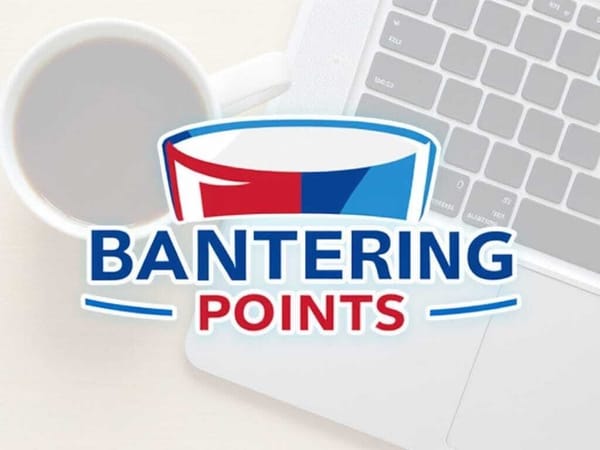Rangers Can Take Hybrid Approach To Improving Center Depth
Rangers could opt for a short-term move to buy time on how they want to proceed in the long term.
In Part 1 of my series that will look at ways the Rangers can address areas of need, I broke down how New York could use an offer sheet, or the threat of one, in an attempt to land one of Anthony Cirelli or Mikhail Sergachev. Such an action would be an aggressive move on the part of Jeff Gorton, and that may not be the preferred path. Gorton could ultimately opt to play it safe and make minor moves for the interim while keeping an eye on the future.
In essence, while adding Cirelli would be great for the team’s center depth, you can make just as strong an argument that taking actions that give the team flexibility now, while not hamstringing them long term could be the best thing to do given the amount of unknown variables in play.
This mainly involves Filip Chytil — primarily what his long term potential is whether it is a good No. 1 center, an elite No. 2 center, or lower — and Mika Zibanejad. Zibanejad more so has to do with what his future looks like beyond his current contract, and whether when he is up for a new deal he’s signing an extension to be a second-line center. I say this because while there’s a high probability he is a Ranger for the majority of the rest of his career, there’s no guarantee that is the case.
Now, you might be saying to yourself, “why in the world would the Rangers move on from Zibanejad?” On the surface, it would appear that there’s no reason to move Zibanejad. He’s been a stellar player for the Rangers, evolved into a No. 1 center, and is coming off a year in which he scored 41 goals in 57 games. He’s also become the face of the team, a leader, and a fan favorite. All of these things are great, but as the Rangers continue their build, they need to be conscious of the money they are spending, and who is getting it.
Zibanejad is 27, and he will be 29 in July of 2022 when his five-year, $26,750,000 deal expires ($5.35 million AAV), and at that point in time the Rangers may not be so eager to pay him the $10 million he reportedly could command.
Via Larry Brooks of the New York Post:
I would be shocked if the Rangers go long term on Strome when they know they are going to have to come up with at least $10 million per to lock up Zibanejad before No. 93 can hit the open market following 2021-22.
Do I think the Rangers re-sign Zibanejad? Yes. Do I think they pay him $10 million a year? Not if they can avoid it. It is unclear what the NHL economy will look like at that point, and there’s no telling what type of level the potential next Rangers captain will be providing.
Not that the situations are directly comparable, but given everything that’s happened since March, you have to wonder if the Rangers regret extending Chris Kreider to the tune of $6.5 million a year for the next seven seasons. There were questions on how the contract would age the minute it was signed, and with Artemiy Panarin and, presumably, Alexis Lafreniere in the picture, the Rangers will be facing the possibility of Kreider being a very expensive third-line player some time soon. Depth is good to have, but there’s depth, and then there’s having someone making $6.5 million play primarily in the bottom-six 5v5.
With all of that said, while the Rangers are weighing their options long term, they should keep a close eye on Aleksander Barkov, a player who could conceivably be a “final” piece that puts the team over the edge when they are in the heart of their contention window.
Before we go any further, just know that I am fully aware that the Florida Panthers will do everything in their power to keep Barkov, and as an extremely valuable player he’s unlikely to move. This is another thought experiment looking at where the Rangers are at, what their needs are, and what could be available to them. That being said, we proceed.
According to Chris Johnston of Sportsnet in February, pre-pandemic, the Panthers were reportedly looking to cut at least $10 million in salary. Some salary was cut when Vincent Trocheck was dealt at the deadline, and more money could be freed up if the team doesn’t re-sign Erik Haula. Given how their season ended, and the recent dismissal of long time general manager Dale Tallon, it’s safe to say that major changes are coming.
As it stands the Panthers have key players like Evgeni Dadonov and Mike Hoffman hitting free agency this year, and will have $20,961,706 in cap space to fill out a roster that already include 13 players for next season. Those 13 include a number of older players on multi-year deals like a 31-year-old Sergei Bobrovsky making $10 million, a 33-year-old Keith Yandle making $6.35 million, and a 34-year-old Anton Stralman making $5.5 million. Then there’s Mike Matheson making $4,875,000 for six more years, which will remain one of Tallon’s biggest WTF moves.
All of that said. Florida does have some prospects who could provide entry-level value like Owen Tippet, Grigori Denisenko, and Henrik Borgstrom, but that still leaves a lot to be desired for the rest of the roster. Given this reality, it will be hard for the Panthers to simultaneously cut costs and build a roster that is strong enough that entices Barkov to stay around after his sweetheart deal worth $5.9 million a season is up in 2021-22.
After a modest start to his career, Barkov has come into his own as a player. The last three seasons he’s averaged over a point per game with a line of 82-154-236 in 227 games. He’s been a top-five Selke finalist in recent years, and his all-around presence would be a much needed addition to a Rangers’ team that could improve defensively. He’s also going to be 27 when he is a free agent, the same age Zibanejad is now, so he would be in a position to have a much longer impact as a No. 1 center which would justify tossing him the bag.
With a new general manager going to Florida, moving a piece as essential as Barkov doesn’t seem likely, especially if they think they can win in the near future. There’s always the possibility that Barkov really wants to stay in Sunrise. Ultimately, this is a situation that will take a bit to play out, but one the Rangers should keep a close eye on.
So if the Rangers were to move on from Ryan Strome and leave Zibanejad as the incumbent No. 1 and Chytil as the No. 2, here are some players who could move up in the event Chytil struggles, or otherwise be a really solid third-line center.
Mikael Granlund, Age 28
Granlund just finished a three-year deal that carried an AAV of $5.75 million that was signed when he was with the Minnesota Wild. The No. 9 overall pick from the 2010 draft was dealt to Nashville during the 2018-19 season, and didn’t have the same success he did in Minnesota.
During the 2019-20 season, Granlund tallied 30 points in 63 games which was a decline from the 54 in 79 he had between Minnesota and Nashville the year prior. In terms of underlying numbers, Granlund had a GF% of 46.85, a CF% of 51.8, and an xGF% of 51.34. He was also worth 3.4 goals above replacement.
Due to his declining production, he’d be a prime candidate for the Rangers to ask about signing a one or two-year deal to help rebuild his value, but I wouldn’t count out a team giving him a decent chunk of change over a few years either.
He was a productive player for a number of years in Minnesota, and he wouldn’t be the first player to join the Rangers to rebuild value and use it as a springboard for a second act of their career. Granlund checks a lot of boxes, and it would be great to have another Finland native to bond with Kaapo Kakko.
Sam Gagner, Age 31
Gagner has had a lengthy NHL career after entering the league at age 18, and in recent years his production hasn’t been as high as he’d like. His last season of acclaim came with the Columbus Blue Jackets in 2016-17 when he finished with a career-best 50 points. Part of his lack of production can be explained by the role and team’s he has been on, which include the Vancouver Canucks, Edmonton Oilers, and Detroit Red Wings.
This year he had a slash line which includes a 38.74 GF%, a 50.63 CF%, and a 50.85 xGF%, which suggests that he was doing the right things, yet not getting rewarded on the score sheet.
The reasons for Gagner include his innate offensive ability and creativity, while his age and status as a journeyman mean he would come cheap. Also enticing is his ability to play with skilled players. By no means is he the best option, but he would offer some decent value at a minimal cap hit.
Carl Soderberg, Age 35
Soderberg is one of the older players on this list, but has a history of production would make him an interesting option as a No. 3 center. This year Soderberg finished with 35 points in 70 games after tallying 49 in 82 the year before. The Malmo, Sweden native would add some size at 6’3” and 210 pounds, and that’s of note because Jeff Gorton has said he wants the Rangers to be tougher to play against.
This past season he had average underlying numbers with a 55.53 GF%, a 46.81 CF%, and a 48.27 xGF%.
Jason Spezza, Age 37
Spezza had a nice season in a veteran leadership role for the Toronto Maple Leafs, and while he’s no longer the game-breaking pivot who was a hallmark of some very talented Ottawa Senators teams, he’s still got a little hockey left in him.
He finished the season with 25 points in 58 games, and averaged 10:50 a game. What is encouraging is that he was two points shy of his production from the year prior, and it took him 18 fewer games.
Spezza’s fancy stats include a GF% of 50.74, a CF% of 50.69, and an xGF% of 52.28. The numbers are admirable for a player who is in the twilight of his career, and after making just $700,000 this season, he won’t break the bank in free agency.
Spezza likely wants to return to Toronto, but could ultimately be replaced by Joe Thornton which would open an opportunity for the Rangers if both parties want a deal.
These are just some options the Rangers could consider via free agency. There’s always the trade market too, and for more on that stay tuned for a story soon from Kevin Power.
Financial information via Cap Friendly. Stats via Evolving-Hockey unless otherwise noted.





